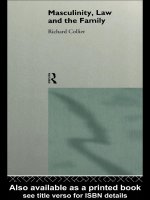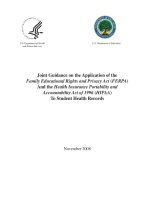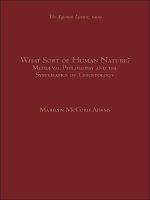The systematics of the crabs of the family varunidae (brachyura, decapoda
Bạn đang xem bản rút gọn của tài liệu. Xem và tải ngay bản đầy đủ của tài liệu tại đây (24.69 MB, 927 trang )
THE SYSTEMATICS OF THE CRABS OF THE FAMILY VARUNINDAE
(BRACHYURA, DECAPODA)
NG NGAN KEE
(B. Sc., NUS)
NATIONAL UNIVERSITY OF SINGAPORE
2006
THE SYSTEMATICS OF THE CRABS OF THE FAMILY VARUNINDAE
(BRACHYURA, DECAPODA)
NG NGAN KEE
(B. Sc., NUS)
A THESIS SUBMITTED FOR THE DEGREE OF DOCTOR OF PHILOSOPHY
DEPARTMENT OF BIOLOGICAL SCIENCES
NATIONAL UNIVERSITY OF SINGAPORE
2006
i
ACKNOWLEDGEMENTS
I would like to thank my supervisor, Professor Peter K.L Ng for his tremendous
patience, exhaustive guidance, and his invaluable discussion about the topic.
Thanks are also due to Professor Peter K.L Ng for his research grants
(RP960314 to Dr. P.K.L. Ng); National Science and Technology Board (now
A*STAR), NUS Research Project grants, Lady McNecice for financial support to attend
conferences and visit to overseas museums.
My deepest gratitude to all the guys and gals (past and present) in the
Systematics and Ecology Laboratory, who had been, and still are, putting up with my
nuisances and nonsense and for their wonderful help (Dr. Darren Yeo, Dr. Tan Swee
Hee, Dr. Tan Heok Hui, Dr. Leong Tzi Ming, Dr. Daisy Wowor; Miss Joelle Lai, Miss
Zeehan Jaafar, Mr. Tran Anh Duc; Mr. Rubeun Gopalasamy, M. Norman Lim; Mr. Jose
Christopher E. Mendoza. Particularly, Dr. Darren Yeo and Dr. Tan Swee Hee for
laboriously going through my thesis despite their heavy workloads, Mr. Tran Anh Duc
and Mr. Mendoza with the photography of the specimens. Dr. Tohru Naruse for his help
with scanning the figures needed in this report.
My sincere thanks to the following colleagues for their guidance and discussion,
and their help with loan of specimens from their respective museums and institutions,
their hospitality when I was visiting their museums:
A) East Asia
Professor Yang Siliang (Beijing National History Museum, Beijing, People’s Republic
of China); Professor Dai Ai-Yun (deceased), Dr. Chen Guoxiao, Dr. Li Shuqiang
(Institute of Zoology, The Chinese Academy of Sciences, Beijing, People’s Republic of
China); Professor Liu Ruiyu, Professor Chen Huilian (deceased), Dr. Li Xinzheng,
Dr. Yu Haiyan (Institute of Oceanography, The Chinese Academy of Sciences,
ii
Qingdao, People’s Republic of China); Dr. Fang Xiaohua (Xiamen Institute of
Oceanology, Xiamen, People’s Republic of China).
Dr. Jeng Meng-Shiou (Institute of Zoology, Academia Sinica, Nankang, Taiwan); Dr.
Wang Chia-Hsiang (National Taiwan Museum, Taipei, Taiwan; Dr. Ho Ping-Ho
(National Museum of Marine Sciences and Oceanology, Taiwan); Dr. Lee Kuan-Xin
(Pei Kuan Museum, Hua-Lian, I-Lan county, Taiwan); Professor Yu Hsiang-Ping,
Professor Chan Tin-Yam (National Taiwan Oceanography University, Keelung,
Taiwan); Dr. Shih Hsi-Te (National Chung Hsing University, Taichung, Taiwan); Dr.
Huang Jung-Fu (National Kaoshiung University of Management and Technology,
Kaohsiung, Taiwan); Dr. Liu Hung-Chang (Institute of Zoology, Academia Sinica,
Nankang, Taiwan).
Dr. Tomuyuki Komai (Natural History Museum & Institute, Chiba, Japan); Dr. Junji
Okuno (Coastal Branch of Natural History Museum & Institute, Chiba, Japan); Dr. M.
Takeda (National Museum of Science and Technology, Tokyo Japan); Professor S.
Shokita, Dr. Yukio Nakasone, Dr. Tohru Naruse (Department of Marine Sciences
and Chemistry, University of Ryukyus, Okinawa, Japan); Dr. K. Muraoka (Kanagawa
Prefectural Natural History Museum, Kanagawa, Japan).
B) South East Asia
Dr. Daisy Wowor (Museum Zoologicum Bogoriense, Research Center for Biology,
Indonesian Institute of Sciences, Cibinong, Indonesia).
BMRI (Marine Research Institute, Universiti Malaysia Sabah, and Sabah Museum,
Malaysia); SMUM (Sabah Museum, Universiti Malaysia, Malaysia).
.
Professor Phaibul Naiyanetr (Department of Biology, Chulalongkhorn University,
Bangkok, Thailand).
Ms. Marivene Manuel (National Museum, Manila, Philippines); Dr. Lawrence Liao
and his students (University of San Carolos, Cebu City, Philippines).
iii
Mrs. Yang Chang Man, Mr. Yeo Keng Loo (deceased), Ms. Lua Hui Kheng, Mr.
Kelvin Lim, Ms. Greasi Simon (Zoological Reference Collection, Raffles Museum of
Biological Research, National University of Singapore, Republic of Singapore)
C) Australia and New Zealand
Dr. Diana Jones, Ms. Melissa Hewitt (Western Australian Museum, Perth, Australia);
Dr. Peter Davie Queensland Museum, Brisbane, Australia); Dr. Shane Ahyong
(National Institute of Water and Atmospheric Research, (NIWA), Wellington, New
Zealand)
Assoc. Professor Colin McLay (School of Biological Sciences, Canterbury University,
Canterbury, New Zealand).
D) India
Professor Antony Fernando; Professor A. Ajamal Khan; Professor T.
Kundapundi; Dr. Olivia Fernando; Dr. S. Ravichandran (Centre of Advanced Study
in Marine Biology, Annamalai University, Porto Novo, India).
E) Europe
Professor Dr. Daniele Guinot, Dr. Alain Crosnier, Dr. Nguyen Ngoc-Ho and Mr.
Regis Cleva (Muséum National d'Histoire Naturelle , Paris, France).
Professor Lipke B. Holthius, Dr. Charles Fransen (Nationaal Natuurhistorisch
Museum [formerly Rijksmuseum van Natuurlijke Historie], Leiden, The Netherlands);
Dr. Dirk Plavoet Zöologisch Museum Amsterdam, Universiteit van Amsterdam,
Amsterdam, The Netherlands).
Professor Micheal Türkay, Dr. Micheal Apel and his team (Senckenberg Natural
History Museum, Frankfurt am Main, Germany); Professor Dr. Angelika Brandt
iv
(Biozentrum Grindel und Zoologisches Museum (formally Zoological Institute and
Museum), Universität Hamburg, Hamburg, Germany); Dr. Oliver Charles Coleman
(Museum für Naturkunde, Humbolt-Universität zu Berlin, Berlin, Germany). ZSM
(Zoolog. Staatssammlung Münich, Münich, Germany).
Dr. Paul F. Clark (Natural History Museum, London, United Kingdom); Dr. Ray
Ingle (Natural History Museum, London, United Kingdom).
Dr. Peter Dworschak (Naturhistorisches Museum in Wien, Vienna, Austria).
Curator (Zoological Museum, University of Copenhagen, Copenhagen, Denmark).
Dr. Ambros Haeggi and Dr. Urs Wüest (Naturhistorisches Museum Basel, Basel,
Switzerland).
South Africa
Ms Liz Hoenson, (South African Museum, Cape Town, South Africa).
United States of America
Dr. Raymond Manning (deceased), Dr. Rafeal Lemaitre and Dr. Chris Tudge
(United States National Museum of Natural History, Smithsonian Institution,
Washington D.C., United States of America); Dr. Patsy A. McLaughlin (Shannon
Point Marine Station, Washington State, United States of America). Mr. George Holm
(Northwest Shell Club, Seattle, United States of America).
Others
I would also like to thank the staff members of Department of Biological Sciences,
National University of Singapore, for their help and support throughout the candidature
period.
v
My sincere thanks to everyone who has contributed to make this study possible.
My family members (Mama, Lao-Pa, Erjie, Sanjie), my cousins, uncles and aunties and
all my friends for standing behind me all these years, especially the past one year during
my personal crisis.
vi
TABLE OF CONTENTS
ACKNOWLEDGEMENTS
i
TABLE OF CONTENT
vi
LIST OF TABLES
x
SUMMARY
xii
DISCLAIMER
xiii
INTRODUCTION
1
A. Importance of varunid crabs
B. Systematics review and brief historical account
C. Aims and Objectives of the present study
1
5
15
MATERIALS AND METHODS
16
TAXONOMY
23
FAMILY VARUNIDAE H. Milne Edwards, 1853
24
Subfamily Varuninae H. Milne Edwards, 1853
36
Key to genera in Varuninae
41
Genus Acmaeopleura Stimpson, 1858
49
Genus Brachynotus De Haan, 1833
55
Genus Cebuanograpsus, new genus
72
Genus Cyrtograpsus Dana, 1852
76
Genus Patagograpsus, new genus 81
Genus Eriocheir De Haan, 1835
86
Genus Hemigrapsus Dana, 1852
125
Genus Austragrapsus, new genus 168
Genus Asiagrapsus, new genus
174
Genus Papyrograpsus, new genus
181
vii
Genus Noarograpsus Ng, Manuel & Ng, 2006
188
Genus Neoeriocheir Sakai, 1983
196
Genus Orcovita Ng & Tomascik, 1994 205
Genus Parapyxidognathus Ward, 1941
231
Genus Platyeriocheir Ng, Guo & Ng, 1999
240
Genus Pseudograpsus H. Milne Edwards, 1837 245
Genus Hirtograpsus, new genus
261
Genus Tanyograpsus, new genus
267
Genus Quadragrapsus, new genus
271
Genus Ptychognathus Stimpson, 1858
278
Genus Gnathograpsus A. Milne-Edwards, 1868
306
Genus Mitragrapsus, new genus
333
Genus Neoptychognathus, new genus
359
Genus Cognatus, new genus
384
Genus Abakos, new genus
395
Genus Pseudogaetice, new genus
400
Genus Pyxidognathus A. Milne-Edwards, 1878
406
Genus Scutumara Ng & Nakasone, 1993
411
Genus Tetragrapsus Rathbun, 1918
423
Genus Utica White, 1847
429
Genus Pseudoutica, new genus
445
Genus Varuna H. Milne Edwards, 1830
451
Subfamily Cyclograpsinae H. Milne Edwards, 1853
468
Key to genera in Cyclograpsinae
476
Genus Cyclograpsus H. Milne Edwards, 1837
478
Genus Chasmagnathus De Haan, 1853
523
viii
Genus Neohelice Sakai, Türkay & Yang, 2006
531
Genus Parahelice Sakai, Türkay & Yang, 2006
536
Genus Pseudohelice Sakai, Türkay & Yang, 2006 552
Genus Helice De Haan, 1835
557
Genus Austrohelice Sakai, Türkay & Yang, 2006
573
Genus Helicana Sakai & Yatsuzuka, 1980 578
Genus Helograpsus Campbell & Griffin, 1966
589
Genus Metaplax H. Milne Edwards, 1852
594
Genus Neometaplax, new genus
627
Genus Paragrapsus H. Milne Edwards, 1853
634
Subfamily Gaeticinae, new subfamily
645
Key to genera in Gaeticinae
648
Genus Setostoma, new genus
649
Genus Gaetice Gistel, 1835
660
Subfamily Thalassograpsinae, new subfamily
673
Genus Thalassograpsus Tweedie. 1950
675
FAMILY XENOGRAPSIDAE, new family
680
Genus Xenograpsus Takeda & Kurata, 1877
708
PHYLOGENETIC ANALYSIS
A) Introduction
B) Materials and Methods
C) Discussion
725
725
725
753
CONCLUSION 766
APPENDIX II 778
APPENDIX III
789
APPENDIX IV
798
ix
LITERATURE CITED 799
x
LIST OF TABLES
Table No
Page
1
List of distinguishing characters of the four subfamilies Varuninae,
Cyclograpsinae, Gaeticinae and Thalassograpsinae within the family
Varunindae.
46
2
Key morphological differences between Eriocheir sinensis, Eriocheir
hepuensis and Eriocheir japonicus. (Modified from Guo et al., 1997)
123
3
Summary of the morphological differences between Neoeriocheir,
Eriocheir and Platyeriocheir. (Modified from Ng et al., 1999)
203
4 Length to width ratios of various ambulatory articles of Orcovita species
(Modified from Ng et al. 1996, and Ng & Ng, 2002).
207
5
Key diagnostic characters of Mitragrapsus altimanus and Varuna litterata
(Modified from Naruse et al., 2005)
346
6
Table showing the key characters distinguishing the three genera
Acmaeopleura (subfamily Varuninae), Setostoma and Gaetice from
subfamily Gaeticinae.
651
7
List of characters distinguishing the seven families of Xenograpsidae,
Varunidae, Grapsidae, Plagusiidae, Glyptograpsidae, Sesaremidae and
Gercarcinidae.
693
8
A comparison between the first stage zoeae of Brachynotus sexdentatus
described by Cuesta et al. 2001a, b, Eriocheir hepuensis by Ng et al., 1998,
Johngarthia planatus by Cuesta et al., 2007, and Xenograpsus testudinatus
from Jeng et al., 2004a.
696
9
A comparison between the first stage zoeas of Gecarcinus lateralis
(Gecarcinidae) by Willems 1982; Johngarthia planatus (Gecarcinidae) by
Cuesta et al., 2007; Glytograpsus impressus (Glytograpsidae) by Cuesta &
Schubart, 1997; Grapsus adscensionis (Grapsidae) by Cuesta et al., 1999;
Plagusia depressa (Plagusiidae) by Wilson & Gore, 1980; Sesarma
aequatoriale (Sesarmidae) by Cuesta et al., 1998; Brachynotus sexdentatus
697
xi
(Varunidae) by Cuesta et al., 2001a, b; Eriocheir hepuensis by Ng et al,
1998, and Xenograpsus testudinatus from Jeng et al., 2004a.
10
Table 10. A comparison between the zoeal characters of the Varunidae as
suggested by Cuesta et al. 2001a, b and those of Xenograpsus testudinatus
described by Jeng et al., 2004a.
699
11
A comparison between the more pronounced megalopa characters of
Brachynotus sexdentatus described by Cuesta et al. 2001a, b, Eriocheir
hepuensis by Ng et al., 1998, Johngarthia planatus by Cuesta et al, 2007,
and Xenograpsus testudinatus described by Jeng et al., 2004a.
700
xii
SUMMARY
Crabs of the family Varunidae are a large group of primarily marine and
freshwater crabs that occur in tropical to temperate seas worldwide. Currently, there are
19 known genera with over 100 known species, many of which are of commercial,
economic, medical and scientific importance. Varunid crabs also have one of the most
diverse habitat ranges, from freshwater to marine, and occurring in caves and high
mountains to the deep sea and hydrothermal vents. The last comprehensive review of
this family was done more than a hundred years ago by Alcock (1900), and many
modern workers still follow the system in which the varunid crabs are regarded as a
subfamily of the Grapsidae. In recent years, however, some molecular and larval studies
have argued for the recognition of these grapsoid subfamilies as full families. The
present study reviews and revises all the genera and species now regarded as members
of the Varunidae to ascertain if the grouping is natural. Its status as a distinct family is
also assessed and its relationship with other taxon examined. A cladistic analysis, using
adult morphological characters, was conducted to examine these relationships. The
study uses traditional characters as well as a variety of new sexual and non-sexual
features which throw new light on how these taxon are identified and classified.
The Varunidae is here shown to be a monophyletic taxa. Within the Grapsoidea,
where the Varunidae belongs, the study also recognizes five other families: Grapsidae
sensu stricto, Sesarmidae, Gercarcinidae, Plagusiidae and Glyptograpsidae. The two
recognized subfamilies in the Varunidae are redefined (notably the Cyclograpsinae),
and two new subfamilies are established – Gaeticinae and Thalassograpsinae. One
enigmatic Indo-West Pacific genus associated with hydrothermal vents, Xenograpsus, is
shown to be unrelated to varunids despite superficial similarities, and is transferred to a
new family, Xenograpsidae. One genus, Gnathograpsus, long synonymised under
Ptychognathus, is resurrected. A total of 13 new genera and eight new species are also
described in this study. All the species, genera and subfamilies are diagnosed and/or
described, and keys are provided.
xiii
DISCLAIMER
THIS REPORT IS NOT TO BE CONSIDERED AS PUBLISHED WORK.
ALL THE NEW NAMES USED IN THIS THESIS HAVE TO BE VALIDATED
IN FORMAL PUBLICATIONS.
1
INTRODUCTION
The crabs of the superfamily Grapsoidea MacLeay, 1838, form a large group of
primarily inter-tidal crabs that occur in tropical to temperate seas worldwide. While
many burrow into soft sediments, others live in crevices and under stones on rocky
shores. Traditionally, this taxon was regarded just as a family (Grapsidae) with four
subfamilies - Grapsinae MacLeay, 1838, Varuninae Alcock, 1900, Sesarminae Dana,
1852, and Plagusiinae 1852, Dana (see Crosnier, 1965). In recent years, this group has
been receiving considerable attention with regards to their alpha taxonomy as well as
phylogeny after reappraisals of their larval, genetic and adult morphology. These studies
point to the need for a more radical re-evaluation of the Grapsidae and Grapsoidea; and
the current consensus is that the traditional subfamilies should be regarded as distinct
families instead, i.e Grapsidae sensu stricto, Varunidae, Sesarmidae and Plagusiidae
(see Schubart et al., 1999; Ng et al., 2001; Martin & Davies, 2001).
The Varunidae was established as a subfamily in 1900 by Alcock (see also later)
for a group of crabs that were found to be straddling between freshwater rivers and
coastal areas. It currently comprises 19 known genera with over 100 known species,
many of which are of commercial, economic and scientific importance. Crabs from this
family are known for their abilities to live in both freshwater and marine environments.
The adults are usually found along the banks of the streams, hidden under rocks or
pebbles, or burrow into the banks of rivers and shorelines. Almost all adults have to
migrate to brackish waters or the open sea for spawning. The larvae of these crabs are
salinity-dependent, and for the freshwater species, the juveniles will migrate back to this
habitat when they metamorphose or are sexually mature.
A. Importance of varunid crabs:
Varunid crabs are important commercially, scientifically and medically Eriocheir
sinensis, E. japonica, Platyeriocheir formosa, Varuna litterata, V. yui and Metaplax
gocongensis etc. are considered by Asians as delicacies. The most commercially
valuable is certainly Eriocheir sinensis (Chinese mitten crabs or Chinese Hairy crab) – a
2
species which has long been acclaimed by East Asians as a delicacy due to its
supposedly unique flavor (Ng, 1998; Peng, 1986; Zhao, 1988; Lai et al., 1992).
Traditionally, Chinese mitten crabs have been harvested near the coast during their
annual migration from freshwater rivers to the coastal areas for spawning. Due to
increased demand and a decrease in supply, the species has been widely cultured for the
last 70 years in almost every part of China (Y. Cai & A. Dai, pers. comm.; Du, 1982;
Zhao, 1986). Platyeriocheir formosa is also widely harvested in Taiwan for food (Ho,
1996; Hung & Yu, 1996; Yu et al., 1996; Jeng, 1997; Jeng & Ng, 1998; Chen, 1998),
while the smaller Eriocheir japonica is collected in many places as well (Ng, 1998;
Kobayashi & Matuura, 1991; Kobayashi et al., 1997). Varuna litterata and V. yui,
although not as popular as Eriocheir, is still sold in many East and South East Asian
markets at a relatively high price when they are available (Ng, 1998; pers. observ.).
Interestingly, the supply of Varuna is somewhat sporadic as nobody has been able to
culture the crab commercially. As for Metaplax gocongensis, the newly molted crabs
are collected in large number on the fifth day of the fifth month of the lunar year in
south Vietnam, for making a special traditional regional dish named ‘mam cong lot’
(salty molted-crab). The carapace, abdomen, stomach and gills are discarded, and the
rest of the crab is preserved in saltwater. This special dish is highly regarded by old
people of the Gocong Province and some gourmets in Ho Chi Minh City. Residents still
living in Gocong Province still make this salty ‘mam cong lot’ every year for gifts. This
dish is also sold to passengers on the ferry-boat in Myloi of Gocong Province (Davie &
Nguyen, 2002).
This family of crabs also contains one species which is on the world’s list of 100
most invasive aquatic invertebrates (Lowe et al., 2004), viz. Eriocheir sinensis. Other
invasive species also include Hemigrapsus penicillatus, Hemigrapsus takanoi, H.
sanguineus, Cyclograpsus integer and Cyclograpsus punctatus. Eriocheir sinensis was
introduced (probably accidentally through ballast water) into Europe (Panning, 1933;
Christiansen, 1969) in the 1920s, and has spread throughout northern Europe. It has
reached the north parts of Norway (Christiansen, 1973), and down south to Portugal
(Cabral & Costa, 1999). The species has entered Britain (Ingle, 1980; Clark, 1984) and
it is now creating problems in the Thames River (P.F. Clark, pers. comm.). It has also
been reported to be found on the Serbian part of the Danube River (Paunoic et al.,
3
2004). It entered North America (Nepszy & Leach, 1973; Cohen & Carlton, 1997) in
the 1970s and its population has increased along the coast of San Francisco (R.B. Doran
& G. Miller, pers. comm.). The crab is still spreading. Two specimens of Eriocheir
sinensis were recently reported from Tokyo Bay, Japan in 2004 (S. Kobayashi, pers.
comm.). In February 2006, the Japanese government established the 'Invasive Alien
Species Act' and free trading and incubation of E. sinensis is strictly restricted as from
February 2006. The Invasive Alien Act is an "Act for preventing adverse effects on
ecosystems caused by invasive alien species", and is targeted at E. sinensis and its sister
species, E. hepuensis. Recently, E. hepuensis has been found in Kuwait (M. Apel, pers.
comm.). Hemigrapsus penicillatus was introduced to the coast of France in 1996 (Noel,
1997) and has been in the Netherlands since then (Faase, et al., 2002). Hemigrapsus
sanguineus has been reported from the east coast of America (Schubart, 2002) and in
Europe (Breton et al., 2002).
Due to their ability to tolerate variable salinities, live out of water for long periods
of time and/or require very little water, several species (adults and larvae) in this family
viz. Eriocheir sinensis, Gaetice depressus, Chasmagnathus convexus etc. have been
extensively used as experimental animals for various physiology, toxicology and heavy
metal studies (e.g. Sullivan, 1977; Péqueux & Gilles, 1981; Péqueux et al., 1984; Gilles,
1996; Zhao et al., 1997; Gimenez & Anger, 2001; Kopin et al., 2001; Rainbow &
Black, 2001; Rodríguez et al., 2001; Luquet et al., 2002; Weihrauch1 et al., 2003; Mo et
al., 2003; Genovese et al., 2004).
The carapace of several species is also quite colorful and/or distinctive, and
combined with their generally docile behaviour, they can make good aquarium pets. For
example, Gaetice depressus (Gistel, 1835) is becoming very popular in some East Asian
countries because of its highly variable colour patterns (Figure 1A) on the carapace
(The Straits Times, 2003). Chasmagnathus convexus De Haan, 1835 (Figure 1B) is so
docile that they can be kept by children as pets, and is often offered for sale in Hong
Kong pet shops (P.K.L. Ng, pers. comm.).
As varunid crabs predominantly live in freshwater or waters with low salinity,
they are an important intermediate host for Paragonimus westermanii (Kerbert, 1878) or
4
the human lung fluke. This disease is very prevalent in Asia, especially in East Asia like
China (Zhong et al., 1981; Xu, 1991; Yu et al., 1994; Yu, 1996; Chui et al., 2001),
Korea (Shin & Joo, 1990; Im et al., 1997), Japan (Mukae et al., 2001; Nakamura-
Uchiyama et al., 2002), Laos, Philippines, India, Sri Lanka, Taiwan (Davies et al.,
1994; WHO, 1995), Thailand (Johnson & Johnson, 1983), and Viet-Nam (Tran Thi,
1997). Paragonimus westermanii is also prevalent in regions where people consume
half-raw or uncooked freshwater crabs living in Central-West Africa, South America
(for example Ecuador, Perù, Venezuela) (WHO, 1995; Vélez et al., 2002).
As a family, varunids, as they are known now, probably have the most diverse
habitat range, from freshwater to marine, from shallow waters to the deep sea, with a
good number living in extreme environments. For example, Varuna litterata is the most
naturally widespread species of varunid, ranging from Africa to across the West Pacific.
Parapyxidognathus deianera is found in mangrove areas, while all Pyxidognathus
species are known from freshwater or near-mangrove sites. Pseudograpsus crassus has
been reported to be found from mountains some 708m in altitude (Tesch, 1918); crabs
from the genus Orcovita are all found in anchialine caves (Ng & Tomascik, 1994); all
Euchirograpsus species live in the deep sea of between 200-290 meters (Crosnier,
2001); crabs from the genus Xenograpsus, are all associated with shallow-water
hydrothermal vents (Jeng et al., 2004) with even one species occurring in deeper water
(McLay, 2006). Crabs from the genus Scutumara and some species of Pseudograpsus
live among intertidal coral sand and loose rubble (Ng et al., 2001), while several species
of Acmaeopleura even form symbiotic associations with tube worms and thalassinid
shrimps (Itani, 2000, 2002, 2003; Itani et al., 2002, 2005).
It is interesting to note that in general, there are very few specimens of many of
the species known from this family in museum collections, except for commercially
important ones like Eriocheir or common intertidal ones like Hemigrapsus and Varuna.
For many species, only the type specimens are available. This can be easily explained
by the fact that not many carcinologists know where to look for the crabs since their
habitats are so specialized and the crabs often have very cryptic habits (e.g.
Pseudograpsus setosus, see Ng et al., 2002).
5
A B
Figure 1. Photographs of Gaetice depressus (Gistel, 1835). A) showing highly variable
coloration, and Chasmagnathus convexus De Haan, 1835; B) showing the docile nature of the
crab.
Many genera of varunid crabs, notably Helice and Cyclograpsus, also
communicate via sound (Sakai et al., 2006). This is done by rubbing the stridulatory
granules on the suborbital ridge against the inner margin of the merus of the cheliped.
Many species also exhibit interesting behaviour like swarming of young crabs as seen in
the megalops of Varuna litterata in Fiji (Ryan & Choy, 1990) and Taiwan (M.S. Jeng,
pers. comm.) and the mass migrations of adults to the sea for spawning, for example,
Pseudograpsus setosus (Ng et al., 2002; K.X. Lee, pers. comm.), Platyeriocheir
formosa (T.Y. Chan, pers. comm.; Ho, 1996; Hung & Yu, 1996; Yu et al., 1996; Jeng,
1997; Jeng & Ng, 1998; Chen, 1998), and Eriocheir sinenis (Y. Cai, A.Y. Dai & R.Y.
Liu, pers. comm.; Du, 1982, Zhao, 1986; Dai et al., 1991; Guo et al., 1997).
Many species of this family also have the potential to be excellent bioindicators.
For example, the presence of Ptychognathus barbatus and Hemigrapsus penicillatus
indicates that the habitat has been adversely affected, as there are usually no other
crustaceans present in the same area (R.Y. Liu, S.H. Ko, pers. comm.; unpublished
data). As for Scutumara, crabs from this genus are usually associated with pristine
beaches with clean coral sand (pers. observ.).
6
B. Systematics Review and Brief Historical Account
The last comprehensive review of the Varunidae was done over 100 years ago by
Alcock (1900). Modern workers still follow the system in which the varunid crabs are
regarded merely as a subfamily within the Grapsidae. The weight of accumulating
evidence suggests, however, that this classification is not parsimonious and it should be
recognized as a full family instead. The family Varunidae has a long and complex
history, and it seems pertinent to give a brief historical account of the family.
The first classification system of this group was provided by De Haan (1833). He
divided the subgenus ‘Grapsi’ into two smaller subgroups based on the form of the third
maxillipeds. The first subgroup included the genera Grapsus, Trichopus (now Varuna),
and Eriocheir. The second subgroup contained Platynotus, Brachynotus, Goniopsis and
Pachysoma (now Sesarma or Chiromantes). In De Haan’s classification, the second
subgroup had contained part of H. Milne Edward’s Cyclograpsi (i.e. Platynotus and
Brachynotus). De Haan had placed Helice and Chasmagnathus in the subgenera
Ocypode (see later).
In his monograph, Dana (1852) established the Grapsoidea, and divided it into
five families, viz. Goneplacidae (sic Gonoplacidae), Macrophthalmidae, Gercarcinidae,
Pinnotheridae, Mictyridae (sic Myctridae) and Grapsidae. He noted that genera like
Helice and Chasmagnathus possessed the characters of the Sesarma, and included them
into his subfamily Sesarminae but he had classifiedd Sesarma, Sarmatium together with
the common character ‘Articulus maxillipedis externi 3tius apice rotundatus’; and he
placed Cyclograpsus, Chasmagnathus and Helice into one group with the common
character ‘Articulus maxillipedis externi 3tius apice truncatus scepeque excavatus’
(Dana, 1852: 133).
Dana (1852: 309) stated that he did not agree with De Haan’s ‘Grapsi’
classification as De Haan had neglected the important distinction based on ‘the male
verges’ or the male mouthpart. He further added that Randall (1839), also had a
‘somewhat similar subdivision’ (Dana, 1852: 329), but stressed that Randall had
7
retained Grapsus under De Haan’s Goniopsis group, and called it Pachygrapsus. Dana
felt that it was not a valid grouping just based on the form of the third maxillipeds.
Thus, he (1852) re-divided the genus Grapsus into Grapsus and Goniopsis, noting that
the Goniopsis was not the same as De Haan’s Goniopsis or Randall’s Pachygrapsus.
Dana (1852: 331) also regarded the Gnathochasmus of MacLeay (1838) and
Cyclograpsus of H. Milne Edwards (1837) to be identical, and gave the group a distinct
name calling it Hemigrapsus. In his subsequent definition of the Grapsinae, Dana used
gape size of the third maxillipeds as a key character, and he further divided the
Grapsinae into two smaller groups, the first group included Pseudograpsus,
Heterograpsus, Eriocheir, Platynotus and Trichopus (or De Haan’s Varuna); and the
second Cyrtograpsus, Grapsus, Goniopsus, Planes and Hemigrapsus (which also
consists of part of De Haan’s Grapsus and part of H. Milne Edwards’s (1834)
Cyclograpsi).
Two years later, H. Milne Edwards (1853: 163) established Varunacaea and
Cyclograpsacaea as two ‘satellite’ tribes, under the ‘Principal group of Grapsaceae,
which was in turn placed under the ‘Deuxième Tribu Principale’ – Grapsinae. He had
also recognized the possible existence of a very distinct group of Varuna-related crabs
within the Grapsinaea; and thus established the satellite tribe, Varunacaea, which
included Varuna, Eriocheir and Utica. In Cyclograpsacea, H. Milne Edwards included
Pseudograpsus, Heterograpsus (now in two genera, Brachynotus and Hemigrapsus),
Paragrapsus, Cyclograpsus, Chasmagnathus and Platynotus (currently Gaetice).
Although there was no mention of the ‘oblique setose piliferous ridge across the
external maxillipeds’, Haswell (1882), in his Catalogue of the Australian Stalked and
Sessile Eyed Crustacea, had placed the genus
Paragrapsus in the subfamily Sesarminae
together with Cyclograpsus, Helice and Chasmagnathus, because Paragrapsus has
‘Orbits and submarginal grooves as in Cyclograpsus …. Legs as in Cyclograpsus.’ He
further commented that ‘This genus is scarcely distinct from Chasmagnathus’ (Haswell,
1882: 104). Examination of this genus by recent workers has confirmed its placement in
the Cyclograpsinae (Campbell & Griffin, 1966).
8
The next major breakthrough was the review by Alcock (1900). Based on his
study of the Indian specimens, Alcock (1900: 288) divided the family Grapsidae into
four distinct subfamilies (1900: 288) viz. Grapsinae, Varuninae, Sesarmine and
Plagusiinae. His subfamily Varuninae is made up of all the Varunacea of H. Milne
Edwards (1853), and part of the Cyclograpsacea (above). According to Alcock (1900),
the subfamily Sesarminae is made up of Sesarmacea and part Cyclograpsacea, with the
front strongly deflexed, the lower border of the orbit commonly runs downwards
towards the angle of the buccal cavern: the external maxillipeds leave a wide
rhomboidal gap between them, an oblique hairy crest transverses them from a point near
the antero-external angle of the ischium to a point near the antero-internal angle of the
merus, their palp articulates either at the summit or near the antero-external angle of the
merus, and their exognath is slender and either partly or almost entirely concealed. The
male abdomen either fills or does not quite fill all the space between the last pair of
ambulatory legs. The antennal flagella conditions are variable, with a strong emphasis
on the oblique crest on the maxiilipeds. He included Sesarma, Sarmatium,
Metasesarma, Clistocoeloma and Metaplax in his diagnosis stating that Metaplax has
the oblique piliferous ridge across the merus and ischium of the external maxillipeds,
the side walls of the body are vertical and like the pterygostomian regions, ornamented
in the usual manner of what he defined as sesarmine crabs.
The subfamily Varuninae was made up of all the Varunacea of H. Milne Edwards
(1853), and part of Cyclograpsacea of H. Milnes Edward (1853), and part of Grapsinae
of Dana (1852). Alcock redefined the Varuninae as having the “front moderately or
little deflexed, sometimes subliminar: the suborbital crest, which supplements the
defective lower border of the orbit, is rather distant from the orbit and usually runs
nearly in a line with the anterior border of the epistome: antennal flagellum usually of
good length: the external maxillipeds do not often gape widely, though usually there is
something of a gap, they are not transversed by any oblique hairy crest, their palp
articulates with the middle of the anterior border of the merus, and their exognath is
generally broad and is exposed throughout. The male abdomen, though not narrow,
rarely covers all the space between the last pair of ambulatory legs”. Alcock (1900) had
only included Varuna, Ptychognathus and Pyxidognathus in his account.
9
Interestingly, Kossmann placed Cyclograpsus and Chasmagnathus into one new
subfamily, Helicinae (1877: 57) on the basis of the morphology of the antennae.
Unfortunately, the form of the antennae from the various species of this subfamily does
not support his separation, and his subfamily was ignored by later workers.
In her studies of ‘The Danish Expedition to Siam’ materials, Rathbun (1909,
1910), placed Camptandrium palucdicola Rathbun, 1909, into subfamily Varuninae, but
her inclusion was not accepted until Balss (1957) (see below). Tesch (1918) followed
Alcock’s (1900) and Borradaile’s (1898) classification of the subfamily Varuninae, but
stressed that Borradaile’s key are not reliable (Tesch, 1918: 70, footnotes). Tesch
further included Ptychognathus, Pyxidognathus, Acmeopleura, Planes, Varuna, Baruna,
Pseudograpsus (part of Dana’s, and = Brachynotus), Utica, Brachynotus, Eriocheir,
Perigrapsus (now Cardisoma carnifex) and Gaetice in the subfamily Varuninae.
In the same year, Rathbun (1918) transferred Cyrtograpsus, Glytograpsus Smith,
1870 and Platychirograpsus into the subfamily Varuninae, and established a new genus
Tetragrapsus for Brachynotus (Heterograpsus) jouji Rathbun, 1893. She did not justify
her inclusion of the three genera in the Varuninae. The classification system has been
rather stable after Tesch (1918), as most workers have considered the subfamily
Sesarminae to contain the genera Sesarma s. l., Sarmatium, Aratus, Holometopus (now
Chiromantes), Metasesarma, Metagrapsus, Cyclograpsus, Chasmagnathus, Helice,
Metaplax and Paragrapsus.
Balss (1922), in his review of Asian decapods, followed Tesch’s (1918)
classification. In his later study (Balss, 1957) on the systematics of the decapods, he
agreed with the subfamily Varuninae classification. However, he noted that in all
members of the Sesarminae, the male abdomen either filled the sternum completely or
nearly so at the fourth ambulatory legs (Balss, 1957: 1669), although he did not
comment further. In addition, he included Cyrtograpsus, Euchirograpsus,
Glyptograpsus and Platychirograpsus in the Varuninae.
10
Crosnier (1965) moved Planes and Ilyograpsus back to the Grapsinae, but did not
elaborate further. At his time, the subfamily Varuninae had the following genera:
Acmeopleura, Brachynotus, Cyrtograpsus, Eriocheir, Euchirograpsus, Gaetice,
Glyptograpsus, Platychirograpsus, Pseudograpus, Ptychognathus, Pyxidognathus,
Utica and Varuna. And it was readily accepted by fellow carcinologists. Sakai (1976)
later established a new genus, Neoeriocheir, for Eriocheir leptognathus Rathbun, 1914,
but did not comment on the grouping of the subfamily.
Guinot (1979), in her extensive studies on the position of the male gonopores,
stated there was a need to check the types of all the species of the subfamily Varuninae.
However, her comments were not acknowledged until Davie (2002). In Guinot &
Bouchard’s (1998) study on the abdominal holding systems of brachyuran crabs, they
again indicated that Varuninae and Sesarminae are paraphyletic, and should be
reviewed. Similarly, Guinot (1979) also indicated that both Metaplax and Cyclograpsus
should be transferred to Varuninae. Guinot & Bouchard’s (1998) work on the locking
buttons of the sternum of Brachyura also indicated likewise. A recent DNA study by
Schubart et al. (2000) suggested that Helice, Chasmagnathus, Cyclograpsus and
Metaplax are not sesarmines but closer to varunines. While Ng et al. (2001)
acknowledged Schubart et al. (2000) report by placing these four genera in the
subfamily Varuninae, they tentatively disagreed with the proposal to recognize
Sesarminae and Varuninae as separate families, stating they preferred to be conservative
while waiting for the morphological studies to be completed. Schubart et al. (2000)
proposal was readily accepted by Martin & Davies (2001) but they did not provide any
comment on the status of the families. Guinot’s statement was finally formalized when
Davie (2002) resurrected the subfamily Cyclograpsinae H. Milne Edwards, 1853, even
though he did not provide any detailed appraisal of the family Varuninae.
While there is not much change within the Varunidae, grapsoid systematics,
however, continues to be in a state of flux. This is especially so in the last few years,
with an overwhelming increase in the number of scientists using molecular biology to
solve confusing taxonomic problems (e.g. Richardson et al., 1986; Hewitt, 1986; Hillis
& Moritz, 1990; Ferrarris & Palumbi, 1996) in systematic biology. This technique has
been applied to crustacean studies (e.g. Keenan et al., 1995; Kitaura et al., 1998,









